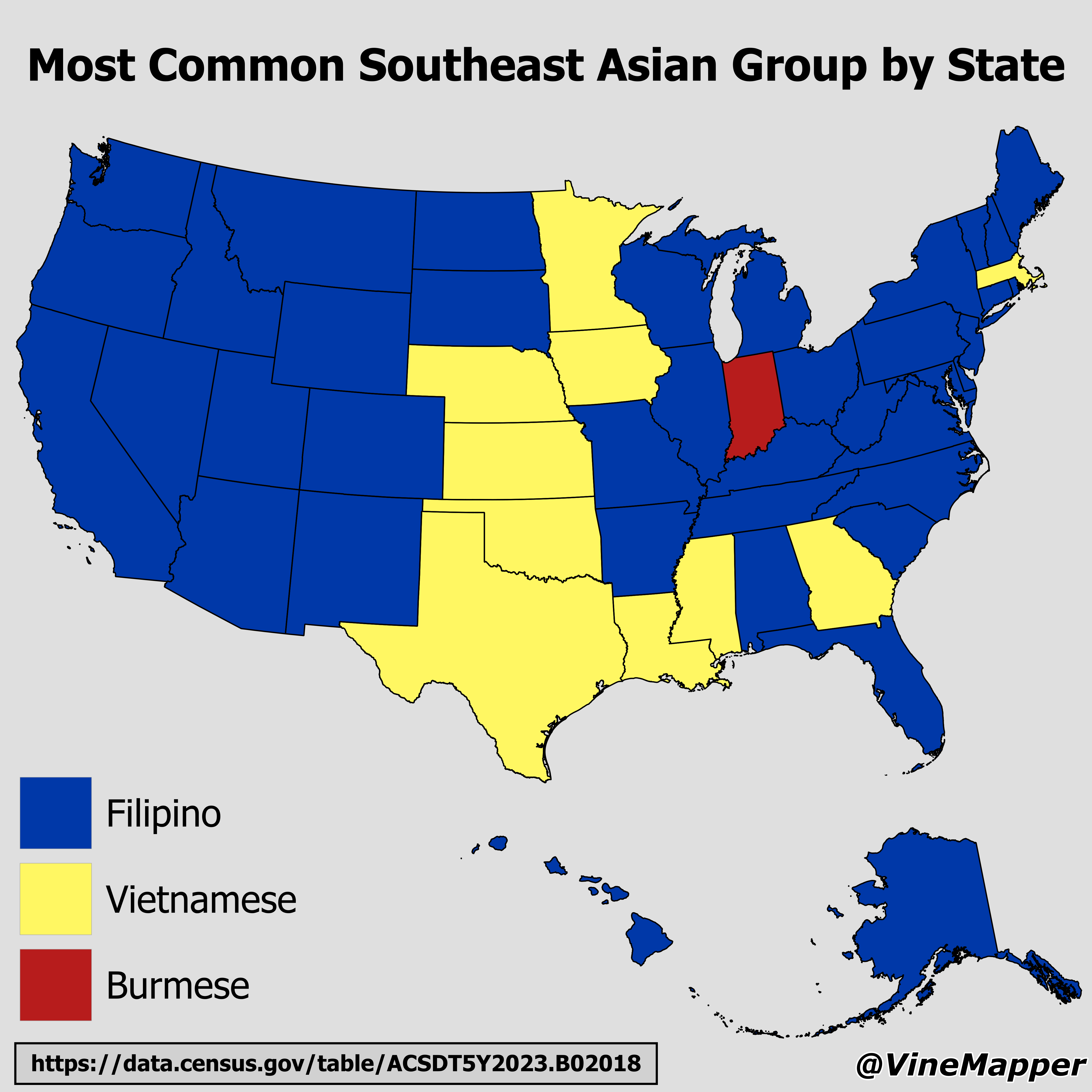Most Common Southeast Asian Group by State Map


David Chen
Data Visualization Specialist
David Chen is an expert in transforming complex geographic datasets into compelling visual narratives. He combines his background in computer science ...
Geographic Analysis
What This Map Shows
The "Most Common Southeast Asian Group by State" map provides a visual representation of the predominant Southeast Asian ethnic groups residing in different states across the United States. By analyzing census data, this visualization highlights the diverse tapestry of cultures that make up the American demographic landscape. Specifically, it showcases which Southeast Asian communities—such as Vietnamese, Filipino, Thai, and Cambodian—are most prevalent in each state. This map not only serves as a geographical reference but also as a window into the migration patterns and community formations of these ethnic groups throughout American history.
Deep Dive into Southeast Asian Demographics
Southeast Asia is a region known for its rich cultural heritage, diverse languages, and vibrant traditions. Countries such as Vietnam, the Philippines, Thailand, Malaysia, and Cambodia contribute significantly to the Southeast Asian diaspora in the U.S. According to the U.S. Census Bureau, over 5 million people of Southeast Asian descent reside in the United States, with a notable presence in states like California, Texas, and New York.
Interestingly, Vietnamese Americans form one of the largest Southeast Asian groups in the U.S., with about 1.5 million individuals, primarily concentrated in cities like Los Angeles and Houston. This community began forming in significant numbers following the Vietnam War, leading to a robust cultural presence characterized by festivals, culinary offerings, and community organizations.
The Filipino population, another major group, exceeds 4 million and has a unique history tied closely to U.S. governance and military presence in the Philippines. States such as California and Nevada boast substantial Filipino communities, which continue to grow due to ongoing immigration and family reunification policies.
In contrast, the Cambodian American community, while smaller, is concentrated in specific areas, notably Long Beach, California, which has one of the largest Cambodian populations outside of Cambodia. Their migration story is intertwined with the Khmer Rouge regime, leading to a significant influx of refugees in the 1970s and 1980s. This history is reflected in the vibrant cultural festivals and the preservation of traditional practices within these communities.
Thai Americans, while fewer in number, also have a notable presence, primarily in states like California and New York. Their communities often serve as cultural hubs, showcasing Thai cuisine and festivals, contributing to the multicultural mosaic of American society.
Regional Analysis
Examining the map, it's clear that states on the West Coast, particularly California, have the highest concentrations of Southeast Asian populations. This can be attributed to historical migration patterns, including the establishment of refugee resettlement programs in the 1970s and 1980s. California's diverse economy and climate have made it an attractive destination for immigrants seeking opportunities.
In the Midwest, states like Minnesota have seen growing populations of Hmong Americans, a subgroup that fled Laos during the Vietnam War. The Hmong community has established a vibrant cultural identity in Minnesota, influencing local traditions and cuisine.
Interestingly, the southern states, particularly Texas, are emerging as new hubs for Southeast Asian populations. The influx of Vietnamese and Filipino communities in cities like Houston reflects broader trends of migration and economic opportunity in the region.
Significance and Impact
Understanding the distribution of Southeast Asian ethnic groups is crucial for several reasons. First, it highlights the ongoing impact of immigration policies and historical events that have shaped the demographic landscape of the United States. Furthermore, the cultural contributions of these communities enrich American society, enhancing its diversity and fostering mutual understanding.
As globalization continues to evolve, Southeast Asian communities are likely to grow, influencing everything from local economies to national politics. Issues such as healthcare access, educational opportunities, and social services become increasingly important as these communities navigate their identities in a multicultural society.
In conclusion, the "Most Common Southeast Asian Group by State" map not only serves as a geographical reference but also invites us to consider the broader narratives of migration, identity, and community in America. By recognizing and celebrating these diverse cultures, we contribute to a more inclusive society, aware of the intersections that define our shared history.
Have you noticed how these communities have shaped local cultures? It's a testament to the power of immigration and the resilience of cultural identity in the face of change.
Visualization Details
- Published
- September 24, 2025
- Views
- 44
Comments
Loading comments...